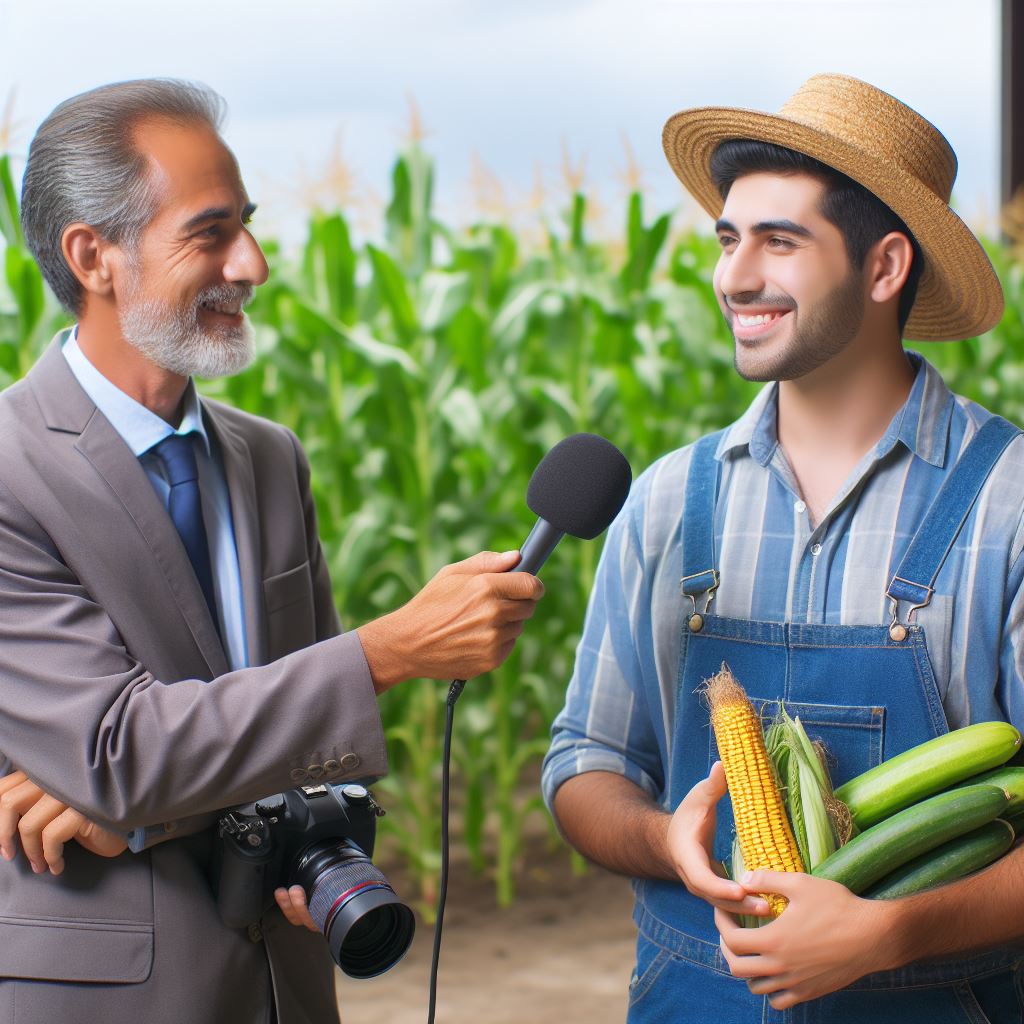Introduction
Effective marketing plays a crucial role in maximizing profit for farmers by promoting their farm products.
This blog post will provide an overview of the importance of marketing and what the content will cover.
Marketing is essential for farmers to maximize their profit as it helps create demand for their farm products.
By effectively showcasing their products, farmers can attract more customers and increase sales, ultimately resulting in higher profits.
In this blog post, we will explore various aspects of farm product marketing that can contribute to maximizing profit.
We will discuss strategies to identify target markets, reach potential customers, and promote farm products effectively.
Additionally, we will delve into the importance of branding and establishing a strong presence in the market for farmers. Building a recognizable brand can lead to increased customer loyalty, repeat purchases, and word-of-mouth recommendations, all of which can drive profits.
Furthermore, we will highlight the significance of understanding consumer preferences and market trends.
By staying informed about what customers want and adapting their marketing strategies accordingly, farmers can position themselves to meet demand and capitalize on emerging opportunities.
Finally, we will discuss the role of technology in modern farm product marketing.
Leveraging online platforms, social media, and e-commerce can expand a farmer’s reach, attract a wider audience, and ultimately boost profits.
In short, effective marketing is crucial for farmers to maximize their profit.
By understanding the importance of marketing strategies and implementing them wisely, farmers can increase sales, build their brand, and adapt to changing market dynamics, ultimately driving profitability.
Understanding target market
Sales and profitability in the farm product market heavily depend on understanding the target market.
By identifying the ideal customer for farm products, conducting research on consumer preferences and demands, and analyzing market trends and competitors, farmers can maximize their profit potential.
Transform Your Agribusiness
Unlock your farm's potential with expert advice tailored to your needs. Get actionable steps that drive real results.
Get StartedIdentifying the ideal customer for farm products
To maximize profit in the farm product market, it is crucial to identify the ideal customer.
Farmers must understand the characteristics of their target market, including demographic factors such as age, gender, location, and income level.
Additionally, studying the psychographic attributes, such as consumer interests, values, and lifestyle choices, can provide valuable insights.
By understanding the ideal customer, farmers can tailor their marketing strategies to meet specific needs and preferences.
For example, if the target market consists mainly of health-conscious individuals, organic farming practices and highlighting the health benefits of the products can attract this customer segment effectively.
Researching consumer preferences and demands
Knowing consumer preferences and demands is essential for maximizing profit.
Farmers should conduct thorough market research to identify the specific farm products that are in high demand.
This research can involve surveys, focus groups, and analyzing sales data.
Furthermore, it is crucial to keep track of the evolving consumer preferences and trends.
Consumer tastes and preferences can change rapidly, influenced by factors such as health trends, environmental concerns, and cultural shifts.
Farmers should regularly update their market research to adapt their products accordingly.
Analyzing market trends and competitors
Analyzing market trends and competitors allows farmers to stay ahead of the competition and identify new business opportunities.
Farmers should closely monitor market trends, such as the popularity of specific products or emerging consumer demands.
Additionally, studying and understanding the strategies of competitors can provide insights on market gaps and potential areas for differentiation.
Farmers can learn from the success or failures of their competitors and adjust their marketing tactics accordingly.
Understanding the target market is vital for maximizing profit in the farm product market.
By identifying the ideal customer, researching consumer preferences and demands, and analyzing market trends and competitors, farmers can develop effective marketing strategies that cater to their customers’ needs and stand out in a competitive market.
Effective market research and analysis provide farmers with valuable insights into the ever-changing dynamics of consumer preferences and behaviors.
By staying informed and adapting their strategies accordingly, farmers can position themselves as industry leaders and maximize their profitability in the farm product market.
Read: Cost Reduction in Farming
Developing a brand identity
Creating a unique selling proposition (USP)
- Identify your strengths: Analyze your farm products and determine what makes them unique compared to your competitors.
- Define your target audience: Understand who your customers are and what they value in farm products.
- Research your market: Conduct market research to identify gaps or opportunities in the market that you can leverage to stand out.
- Determine your USP: Based on your strengths, target audience, and market research, develop a unique selling proposition that communicates the value of your farm products.
Branding strategies to stand out in the market
- Develop a compelling brand story: Craft a narrative that tells the story of your farm, highlighting its history, values, and commitment to quality.
- Design a memorable logo: Create a visually appealing and unique logo that represents your farm and resonates with your target audience.
- Establish a consistent visual identity: Use consistent colors, fonts, and imagery across all marketing materials to create a cohesive and recognizable brand.
- Communicate your brand values: Clearly articulate the values and mission of your farm through various marketing channels, such as website content, social media posts, and packaging.
Establishing a strong brand presence through marketing channels
- Build a professional website: Create a user-friendly website that showcases your farm products, brand story, and contact information. Optimize it for search engines to increase visibility.
- Utilize social media: Maintain active profiles on relevant social media platforms to engage with your audience, share updates, and promote your farm products.
- Engage in content marketing: Create informative and engaging content such as blog posts, videos, and infographics related to farm products to establish yourself as an industry expert.
- Participate in local events and farmers’ markets: Showcase your products in farmers’ markets or local events to connect with your community and generate brand awareness.
- Collaborate with influencers and community partners: Partner with influential individuals or organizations in the agricultural industry to expand your reach and gain credibility.
- Implement customer loyalty programs: Reward your loyal customers with exclusive discounts, promotions, or personalized experiences to foster long-term relationships.
- Seek customer feedback and reviews: Actively encourage customers to provide feedback and reviews, which can help build trust and improve your farm products.
- Monitor and analyze brand performance: Regularly evaluate your branding efforts through analytics and customer feedback to identify areas for improvement and capitalize on successful strategies.
Generally, developing a strong brand identity is crucial for maximizing profit in farm product marketing.
By creating a unique selling proposition, implementing effective branding strategies, and establishing a strong brand presence through various marketing channels, farmers can differentiate themselves in the market and attract loyal customers who value their products.

Product positioning and differentiation
To maximize profit in farm product marketing, adopt strategic approaches:
- Emphasize unique features and benefits.
- Identify market gaps for product excellence.
- Tailor positioning for specific consumer segments.
- Develop a compelling Unique Selling Proposition (USP).
- Communicate the USP effectively through various channels.
- Consistently deliver on promises for trust and loyalty.
- Stay updated on market trends and adapt strategies accordingly.
Effective product positioning and differentiation are crucial for farm product marketing success.
Showcase Your Farming Business
Publish your professional farming services profile on our blog for a one-time fee of $200 and reach a dedicated audience of farmers and agribusiness owners.
Publish Your ProfileHighlighting unique features, addressing market gaps, and tailoring positioning to specific consumer segments enhance market presence.
Developing a compelling Unique Selling Proposition (USP) sets products apart and fosters brand identity.
Clear communication of the USP through various channels attracts consumer attention.
Consistently delivering on promised features and benefits builds trust and encourages repeat purchases.
Monitoring market trends and adapting strategies ensure long-term success and profitability in the farm product industry.
Adopting a strategic approach maximizes profit and market share, creating a strong foundation for sustained success in farm product marketing.
Read: Innovative Agri Business Models
Building and maintaining customer relationships
Importance of customer loyalty and repeat business
Customer loyalty is crucial for the success of any business, including those in the farm product marketing industry.
Loyal customers not only continue to purchase products but also become advocates, spreading positive word-of-mouth about the brand.
Building customer loyalty starts with providing a quality product that meets or exceeds customer expectations.
By consistently delivering on promises, businesses can establish trust and reliability, encouraging customers to return for future purchases.
Repeat business is highly valuable because it reduces the costs associated with acquiring new customers.
It is often more expensive to acquire a new customer than to retain an existing one.
A loyal customer base also provides a stable revenue stream, helping to maximize profits.
Implementing customer retention strategies
To ensure customer retention, businesses need to go beyond simply offering a good product.
They must focus on creating a positive customer experience at every touchpoint, from initial contact to post-purchase support.
One effective strategy is to provide personalized service tailored to individual customer needs.
This can be achieved by collecting and analyzing customer data to gain insights into preferences, purchasing patterns, and demographics.
By understanding customers on a deeper level, businesses can offer targeted promotions and recommendations.
Another important aspect of customer retention is effective communication.
Promptly addressing customer inquiries, resolving issues, and actively seeking feedback helps to build trust and strengthen relationships.
Businesses can utilize various channels such as phone, email, social media, and live chat to stay connected with customers.
Utilizing customer feedback to improve products and services
Customer feedback serves as a valuable tool for continuous improvement.
By actively seeking and analyzing customer feedback, businesses can identify areas for improvement and make necessary adjustments to products and services.
Feedback can be collected through surveys, online reviews, focus groups, or even informal conversations.
It is important to encourage honest and constructive feedback, as it provides valuable insights into customer satisfaction and preferences.
This information can then be used to refine marketing strategies, enhance product features, or develop new offerings.
Acting upon customer feedback also demonstrates a commitment to meeting customer needs and creates a sense of ownership among customers.
When customers see their suggestions implemented, they feel valued and are more likely to continue supporting the brand.
In fact, building and maintaining strong customer relationships is essential for maximizing profit in farm product marketing.
By focusing on customer loyalty and repeat business, implementing effective retention strategies, and utilizing customer feedback, businesses can cultivate a loyal customer base and drive sustained success.
Read: Farm Management Best Practices
Effective pricing strategies
Effective pricing is crucial for farm product marketing success. Consider these strategies:
- Cost-plus Pricing: Calculate production costs and add a markup for profit.
- Value-based Pricing: Assess product qualities and set prices according to perceived value.
- Market-based Pricing: Adjust prices based on market conditions, demand, and supply fluctuations.
Striking a balance between profitability and competitiveness is essential.
Regularly analyze market trends, adjust prices during fluctuations, and be mindful of factors like seasonality and consumer preferences.
During high demand, capitalize on market conditions with justified price increases. In periods of oversupply, stimulate sales by lowering prices to maintain cash flow.
Conduct market analysis, use consumer feedback, and consider product quality when making informed pricing decisions.
Premium or organic products can command higher prices.
Avoid overly optimistic pricing to prevent deterring price-sensitive customers. A careful balance ensures profitability and success in the dynamic agricultural market.
Read: Agribusiness Success Stories
Showcase Your Farming Business
Publish your professional farming services profile on our blog for a one-time fee of $200 and reach a dedicated audience of farmers and agribusiness owners.
Publish Your ProfileLeveraging digital marketing tools
Successful farm product marketing involves the effective use of digital marketing tools and strategies to maximize profit.
In today’s digital age, farmers have access to various platforms and techniques that can significantly improve their marketing efforts and reach a wider audience.
Here are three key tools that farmers can leverage to enhance their farm product marketing:
Creating a professional and user-friendly website
Having a well-designed and user-friendly website is essential for any business, including farmers.
A website serves as a digital storefront where potential customers can learn more about the farm products, place orders, and contact the farmers directly.
To maximize profits, farmers should ensure their website is visually appealing, easy to navigate, and mobile-friendly to cater to a wider audience.
Utilizing social media platforms for product promotion
Social media platforms, such as Facebook, Instagram, and Twitter, provide an excellent opportunity for farmers to showcase their farm products and connect with potential customers.
Farmers can create business profiles or pages on these platforms, regularly post high-quality images and descriptions of their products, and engage with customers through comments and direct messages.
By utilizing social media, farmers can significantly increase their product visibility and build a loyal customer base.
Utilizing content marketing to reach and engage with the target audience
Content marketing involves creating and sharing valuable and relevant content, such as blog posts, videos, and infographics, to attract and engage with the target audience.
Farmers can leverage content marketing to educate consumers about their farm products, share recipes and cooking tips, as well as highlight the benefits of buying directly from the farm.
By providing valuable content, farmers can build trust, establish themselves as experts in their field, and ultimately drive sales.
In addition to these tools, farmers can also implement specific strategies to maximize the impact of their digital marketing efforts:
- Implementing search engine optimization (SEO) techniques to ensure their website appears in relevant search results, increasing organic traffic and visibility.
- Investing in online advertising campaigns, such as Google Ads or Facebook Ads, to target specific demographics and generate more leads.
- Collaborating with influencers or bloggers in the food and agriculture industry to increase brand awareness and credibility.
- Implementing email marketing campaigns to nurture customer relationships, promote special offers, and encourage repeat purchases.
- Monitoring and analyzing website and social media analytics to adjust marketing strategies and optimize performance.
By leveraging these digital marketing tools and strategies, farmers can effectively market their farm products, reach a wider audience, and maximize profitability.
However, it is essential to continually evaluate and adapt marketing efforts to stay relevant in the ever-evolving digital landscape.
Embracing digital marketing tools can significantly contribute to the success and profitability of farm product marketing in today’s competitive market.
Collaborating with partners and influencers
Collaborating with partners and influencers is a crucial strategy for maximizing profit in the farm product marketing industry.
By forming partnerships with retailers, restaurants, and other relevant businesses, farmers can expand their distribution channels and reach a wider customer base.
Forming partnerships with retailers, restaurants, and other relevant businesses
One effective way to maximize profit in farm product marketing is by forming partnerships with retailers, restaurants, and other relevant businesses.
By collaborating with these entities, farmers can gain access to established distribution networks and tap into existing customer bases.
When selecting potential partners, farmers should consider businesses that align with their values and target market.
For example, a farmer who specializes in organic produce may seek partnerships with health food stores or farm-to-table restaurants.
Partnerships can take various forms, such as co-marketing initiatives, joint promotions, or distribution agreements.
By leveraging their respective strengths, farmers and partners can create win-win situations that result in increased sales and profitability for both parties.
Leveraging influencer marketing to expand product reach
In recent years, influencer marketing has emerged as a powerful tool for expanding product reach and increasing profitability.
Farmers can collaborate with social media influencers, bloggers, and industry experts to promote their farm products to a wider audience.
When selecting influencers to collaborate with, farmers should look for individuals who have a strong following in their target market.
For example, a farmer selling artisanal cheeses may partner with a popular food blogger known for her expertise in gourmet cuisine.
Influencer collaborations can take different forms, such as sponsored content, product reviews, or social media takeovers.
By leveraging the influencers’ credibility and reach, farmers can generate buzz around their products and attract new customers.
Participating in trade shows and conferences to establish industry connections
Trade shows and conferences provide valuable opportunities for farmers to establish industry connections and showcase their products to potential partners and customers.
By participating in these events, farmers can network with key players in the field and gain insights into market trends.
When selecting trade shows and conferences to attend, farmers should consider events that are relevant to their niche and target market.
For example, a farmer specializing in organic skincare products may participate in a natural beauty expo.
At these events, farmers should focus on building relationships with retailers, distributors, and industry influencers who can help promote their products.
By making meaningful connections and showcasing the quality and uniqueness of their farm products, farmers can increase their chances of securing lucrative partnerships and distribution deals.
In general, collaborating with partners and influencers is an effective strategy for maximizing profit in the farm product marketing industry.
By forming partnerships with retailers, restaurants, and other relevant businesses, leveraging influencer marketing, and participating in trade shows and conferences, farmers can expand their reach, attract new customers, and ultimately increase their profitability.
Monitoring and analyzing marketing performance
Monitoring and analyzing marketing performance is crucial for farm product marketing.
It allows farmers to assess the success of their marketing efforts and make data-driven decisions to maximize profit.
Showcase Your Farming Business
Publish your professional farming services profile on our blog for a one-time fee of $200 and reach a dedicated audience of farmers and agribusiness owners.
Publish Your ProfileSetting measurable marketing goals and objectives
- Establish clear and specific marketing goals and objectives to measure success.
- Goals can include achieving a certain sales volume, increasing market share, or improving brand awareness.
- Objectives should be measurable and have a set timeframe for evaluation.
- Setting specific goals and objectives provides focus and direction for marketing efforts.
Utilizing analytics tools to track marketing efforts
- Use analytics tools like Google Analytics to track website traffic, conversions, and customer behavior.
- These tools provide valuable insights into the effectiveness of different marketing strategies.
- Analyze metrics such as click-through rates, bounce rates, and conversion rates to identify areas for improvement.
- Regularly monitor and analyze data to understand what marketing tactics are working and what needs adjustment.
Making data-driven decisions to optimize marketing strategies
- Use the data collected to make informed decisions about marketing strategies.
- Identify the most effective channels for reaching target customers.
- Allocate marketing budgets based on which channels deliver the highest return on investment.
- Identify demographics and customer segments that respond positively to marketing efforts.
- Adjust marketing messages and tactics based on consumer preferences and market trends.
Monitoring and analyzing marketing performance is an ongoing process that should be integrated into the overall marketing strategy.
By setting measurable goals, utilizing analytics tools, and making data-driven decisions, farmers can optimize their marketing efforts and maximize profit.
Conclusion
In this blog post, we discussed key points regarding effective farm product marketing. We emphasized the significance of this aspect in maximizing profit for farmers.
By implementing the strategies outlined, readers can ensure better returns from their agricultural endeavors.
Farmers should remember that marketing plays a vital role in their overall success. It is essential to identify target markets, develop strong branding, and utilize various marketing channels.
Efficient pricing and distribution strategies can also contribute to higher profitability.
By focusing on consumer needs and preferences, farmers can create value-added products and build strong customer relationships.
Implementing effective marketing strategies can result in increased sales and enhanced market visibility.
To maximize profit, farmers need to stay up-to-date with market trends, monitor competition, and regularly evaluate their marketing strategies.
By adapting to changing consumer demands and effectively promoting their products, farmers can command higher prices and increase their profit margins.
We hope this blog post has provided valuable insights and guidance to our readers.
Remember, effective farm product marketing is key to success in today’s competitive agricultural landscape.
Start implementing these strategies and reap the benefits of increased profitability in your farming business.




